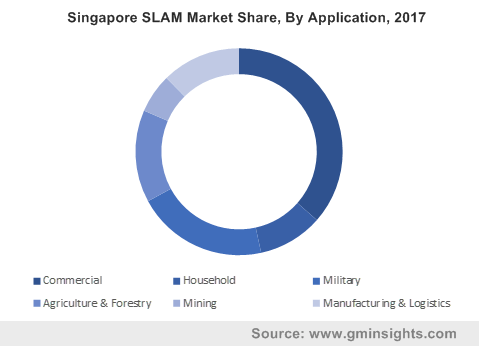Rising AR deployment to drive SLAM technology market, escalating adoption of autonomous vehicles to augment the industry landscape
Publisher : Fractovia | Published Date : October 2018Request Sample
The advent of virtual and augmented reality has transformed the dynamics of SLAM (Simultaneous Localization & Mapping) technology market. A spate of end-users right from the automotive and aerospace to UAV manufacturers have been integrating SLAM technology in their autonomous systems on a large scale. In addition, technology companies like Google have also been involved in the deployment of SLAM technology. The capability of this technology to enhance the 3D vision of surroundings with the assistance of location and mapping function is poised to enhance the simultaneous localization & mapping technology industry share over the years ahead.
Singapore SLAM Market Share, By Application, 2017

The increasing popularity of autonomous vehicles lately has been fueling the demand for SLAM technology. The science of augmented reality (AR) incorporated with light detection and ranging (Lidar) helps the vehicle navigate through locations where GPS doesn’t work. In fact, the automotive companies involved in the development of driverless cars have been using SLAM technology to generate a 3D map of surroundings with the help of roof-mounted Lidar sensors. The companies involved in the modernization of artificial intelligence (AI) like Cortica have already deployed SLAM technology in the driverless cars across Israel, which has set a benchmark for other tech giants.
Speaking more about the use of SLAM technology in the autonomous systems, the Internet giant, Google has observed the effective use of this technology in its driverless cars. It overcomes the limitation of Lidar systems which take more time to respond to the input received from location sensors. The ability of SLAM technology to respond quickly to the change in the location in accordance with a moving vehicle at high speed has been fueling its deployment not in autonomous vehicles such as driverless cars, and UAV but also in the mining and manufacturing sectors.
Recently, the Germany based car manufacturer, Porsche has invested in Swiss startup company, WayRay to develop next-generation navigation systems. WayRay produces holographic augmented reality display technology that integrates virtual objects into driving assistance. The German car manufacturer is planning to use WayRay’s virtual SLAM technology in its product ranges to offer modernized technology to the customers. Likewise, recently, the consortium of Toyota Motor Corp comprising Denso Corp, Jtekt Corp, Advics, and Aisin Seiki Co, decided to form a joint venture to develop new software that will help to operate components of autonomous vehicles. The strategic investment by the automaker in JVs with technology companies for fulfilling changing consumer demands is likely to propel simultaneous localization & mapping (SLAM) technology industry share.
With the increasing use of SLAM technology in the various robotic applications for navigation purposes, players in the simultaneous localization & mapping technology market have been developing new software to improve the existing facilities. For instance, the developer of software to map and navigate the indoors, NavVis has developed a software that can reduce the problems related to the mapping miscalculations. This new variant of software enables users to access and interact with 3D maps and building models from any devices. The shifting focus of the tech giants toward the development of efficient and high-speed SLAM technology is likely to stimulate the product demand over the years ahead.
The extensive use of software-assisted SLAM technology in drones and driverless cars is poised to fuel the simultaneous localization & mapping technology market trends over the years ahead. Taking into account the capability of this system to discover the complex obstacles in the absence of GPS, myriad countries have been deploying drones installed with SLAM technology for surveillance and protecting international borders. In addition, the growing preference for drones across mining and construction projects for the facility management, security, and mapping is slated to enhance the product demand. With the surging use of real-time 3D maps, simultaneous localization & mapping (SLAM) technology market will surpass a revenue collection of USD 2 billion by the end of 2024.